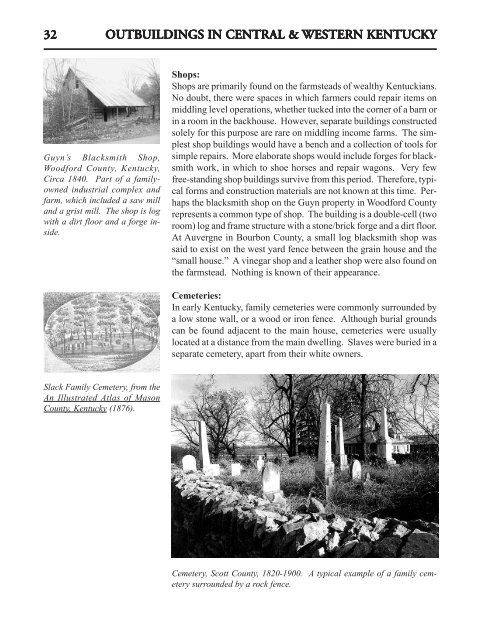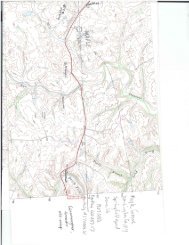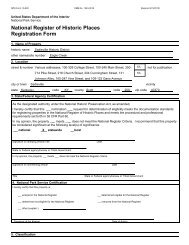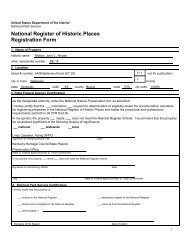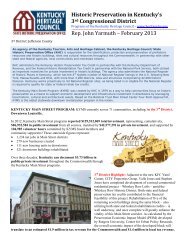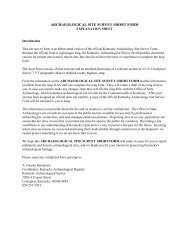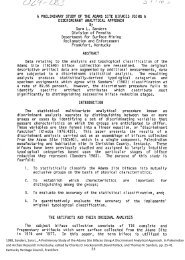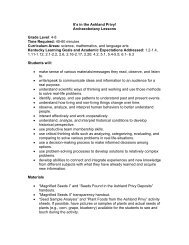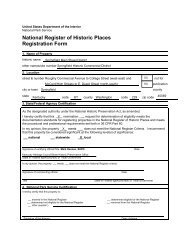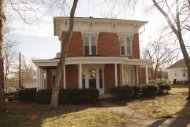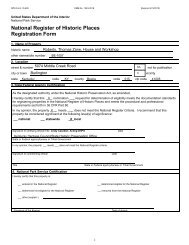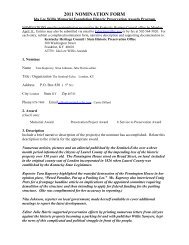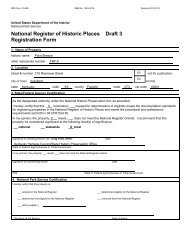Agricultural and Domestic Outbuildings in Central and Western
Agricultural and Domestic Outbuildings in Central and Western
Agricultural and Domestic Outbuildings in Central and Western
You also want an ePaper? Increase the reach of your titles
YUMPU automatically turns print PDFs into web optimized ePapers that Google loves.
32<br />
32<br />
Guyn’s Blacksmith Shop,<br />
Woodford County, Kentucky,<br />
Circa 1840. Part of a familyowned<br />
<strong>in</strong>dustrial complex <strong>and</strong><br />
farm, which <strong>in</strong>cluded a saw mill<br />
<strong>and</strong> a grist mill. The shop is log<br />
with a dirt floor <strong>and</strong> a forge <strong>in</strong>side.<br />
Slack Family Cemetery, from the<br />
An Illustrated Atlas of Mason<br />
County, Kentucky (1876).<br />
OUTB OUTBUILDINGS OUTB OUTB UILDINGS IN IN CENTRAL CENTRAL & & WESTERN WESTERN WESTERN KENTUCKY<br />
KENTUCKY<br />
KENTUCKY<br />
Shops:<br />
Shops are primarily found on the farmsteads of wealthy Kentuckians.<br />
No doubt, there were spaces <strong>in</strong> which farmers could repair items on<br />
middl<strong>in</strong>g level operations, whether tucked <strong>in</strong>to the corner of a barn or<br />
<strong>in</strong> a room <strong>in</strong> the backhouse. However, separate build<strong>in</strong>gs constructed<br />
solely for this purpose are rare on middl<strong>in</strong>g <strong>in</strong>come farms. The simplest<br />
shop build<strong>in</strong>gs would have a bench <strong>and</strong> a collection of tools for<br />
simple repairs. More elaborate shops would <strong>in</strong>clude forges for blacksmith<br />
work, <strong>in</strong> which to shoe horses <strong>and</strong> repair wagons. Very few<br />
free-st<strong>and</strong><strong>in</strong>g shop build<strong>in</strong>gs survive from this period. Therefore, typical<br />
forms <strong>and</strong> construction materials are not known at this time. Perhaps<br />
the blacksmith shop on the Guyn property <strong>in</strong> Woodford County<br />
represents a common type of shop. The build<strong>in</strong>g is a double-cell (two<br />
room) log <strong>and</strong> frame structure with a stone/brick forge <strong>and</strong> a dirt floor.<br />
At Auvergne <strong>in</strong> Bourbon County, a small log blacksmith shop was<br />
said to exist on the west yard fence between the gra<strong>in</strong> house <strong>and</strong> the<br />
“small house.” A v<strong>in</strong>egar shop <strong>and</strong> a leather shop were also found on<br />
the farmstead. Noth<strong>in</strong>g is known of their appearance.<br />
Cemeteries:<br />
In early Kentucky, family cemeteries were commonly surrounded by<br />
a low stone wall, or a wood or iron fence. Although burial grounds<br />
can be found adjacent to the ma<strong>in</strong> house, cemeteries were usually<br />
located at a distance from the ma<strong>in</strong> dwell<strong>in</strong>g. Slaves were buried <strong>in</strong> a<br />
separate cemetery, apart from their white owners.<br />
Cemetery, Scott County, 1820-1900. A typical example of a family cemetery<br />
surrounded by a rock fence.


